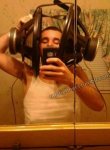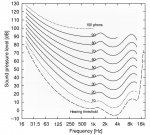Hello people!
The last few months have been a real adventure into this whole "bedroom studio" thing, so I have some tips for others out there about mixing at home with headphones (mainly), but I also have a question for you guys.
First, everyone says that mixing on headphones is a "bad idea" (and just get some studio monitors), and in some important ways I AGREE (see below), but since that wasn't really a good option for me, I decided to focus in on headphones and the technology around it. I also had to do this on a semi-low budget.
So, I'll share what I've picked up and then I have a question for you guys.
Here's my setup, and why:
1) KRK KNS6400 headphones. They aren't great, but they aren't bad for $99 bucks. They have a flat response, they are fairly clear, and I couldn't tell a lot of difference from other similarly priced headphones. Frankly, the guy at the local music store turned me on to them (reluctantly meeting my budget). If I had to buy these again, I'd go for the Sennheiser 280 Pros. They are a tad bit better than the KRKs, but not by much, imo.
2) Toneboosters Isone VST plugin. (15 Euros or about $25 dollars.) Basically, this is a "speaker emulation" plugin that takes headphones and makes them sound more like studio monitors. One great thing about this plugin (and also a pain), is that you can calibrate the plugin to closely match actual physical monitors (I did this with my M-Audio BX5 D2 monitors) and so you can get a mix very close to your physical monitors without using the monitors! Calibrate during the day, then mix at night, for example. You only have to calibrate this once, so you can borrow someone else's monitors to do that, then give them the monitors back. You put this on the Master track of your mix after all the other effects. It works quite well IF you follow the instructions for setting it up!
3) Focusrite's VRM module. ($99). This module is great! It emulates everything from crappy PC speakers, or TV speakers up through high priced studio monitors. No, it won't actually replace those high end monitors, but it very much allows you to test your mix on a variety of various devices without actually owning a studio or those monitors, and without having to run around playing your mix physically, plus it has 3 room models to boot. It's absolutely worth the money, imo. One note: You can't calibrate this to match your monitors, so get Isone if you need to do calibrate your sound.
So, for about $250 you get a decent set of headphones and some gear to make it easier to reference your mix. If you are stuck on headphones, try what I suggested! =)
However, NONE of this (including the BX5 monitors) does much in the sub-bass department. Even the BX5s barely register in the sub-bass range. So, that's the problem I am running into now: How to hear and mix sub-bass (quietly!).
Technically, you need a proper sub woofer to move a lot of air at very low frequencies to get that "thump" you feel in dance music, and you just can't get that on headphones. It's also fairly expensive ($400~) to get into even a basic decent subwoofer. Also, getting one defeats the whole purpose of using headphones: To be able to mix without disturbing the neighbors!
So, I have given up on the idea of being able to faithfully replicate sub bass on headphones, because it is more tactile than audio, but I can still try and get CLOSE enough to be able to guess what the mix will sound like on actual woofers.
To do this:
1) The headphones have to play frequencies between 20-40hz and
2) The headphones have to also have warm mids and clear highs
My question is: What headphones would you recommend, $200 and under, than can do 20-40hz at an audible level and don't suck?
The best candidate I have found thus far are these:
Sony MDR-XB700
Anyone have any suggestions? Here are some headphones mentioned by others, but I don't know if any of them can audibly represent sub-bass:
Sennheiser HD25-1 II
Audio-Technica ATH-M50
Audio Technica ATH-WS55
Beyerdynamic DT150
Beyerdynamic DT770 Pro
V-MODA M-80
Sony MDR7506
Thanks for the feedback, and I hope my tips help someone! =)
(PS: I posted a similar question earlier, but I think I hit the wrong button. If so, sorry for the duplicate!)
---------- Post added at 09:21 PM ---------- Previous post was at 07:59 PM ----------
Just wanted to add a couple of clarifications to the previous post:
1) Don't use Tonebooster's Isone and Focusrite's VRM at the same time. You'll want to use one or the other. (Using the bypass switch in your DAW to switch to the VRM is an easy way to do this).
2) What I am really looking for in terms of sub bass is just being able to hear the tone, and know that's it's there. I'll for sure have to actually reference this on actual monitors or speakers after the initial mix. Right now, I can't hear ANY sub bass, so I don't even know if the notes are right or not. I plan on using a spectrum analyzer with the headphones.
Thanks!
The last few months have been a real adventure into this whole "bedroom studio" thing, so I have some tips for others out there about mixing at home with headphones (mainly), but I also have a question for you guys.
First, everyone says that mixing on headphones is a "bad idea" (and just get some studio monitors), and in some important ways I AGREE (see below), but since that wasn't really a good option for me, I decided to focus in on headphones and the technology around it. I also had to do this on a semi-low budget.
So, I'll share what I've picked up and then I have a question for you guys.
Here's my setup, and why:
1) KRK KNS6400 headphones. They aren't great, but they aren't bad for $99 bucks. They have a flat response, they are fairly clear, and I couldn't tell a lot of difference from other similarly priced headphones. Frankly, the guy at the local music store turned me on to them (reluctantly meeting my budget). If I had to buy these again, I'd go for the Sennheiser 280 Pros. They are a tad bit better than the KRKs, but not by much, imo.
2) Toneboosters Isone VST plugin. (15 Euros or about $25 dollars.) Basically, this is a "speaker emulation" plugin that takes headphones and makes them sound more like studio monitors. One great thing about this plugin (and also a pain), is that you can calibrate the plugin to closely match actual physical monitors (I did this with my M-Audio BX5 D2 monitors) and so you can get a mix very close to your physical monitors without using the monitors! Calibrate during the day, then mix at night, for example. You only have to calibrate this once, so you can borrow someone else's monitors to do that, then give them the monitors back. You put this on the Master track of your mix after all the other effects. It works quite well IF you follow the instructions for setting it up!
3) Focusrite's VRM module. ($99). This module is great! It emulates everything from crappy PC speakers, or TV speakers up through high priced studio monitors. No, it won't actually replace those high end monitors, but it very much allows you to test your mix on a variety of various devices without actually owning a studio or those monitors, and without having to run around playing your mix physically, plus it has 3 room models to boot. It's absolutely worth the money, imo. One note: You can't calibrate this to match your monitors, so get Isone if you need to do calibrate your sound.
So, for about $250 you get a decent set of headphones and some gear to make it easier to reference your mix. If you are stuck on headphones, try what I suggested! =)
However, NONE of this (including the BX5 monitors) does much in the sub-bass department. Even the BX5s barely register in the sub-bass range. So, that's the problem I am running into now: How to hear and mix sub-bass (quietly!).
Technically, you need a proper sub woofer to move a lot of air at very low frequencies to get that "thump" you feel in dance music, and you just can't get that on headphones. It's also fairly expensive ($400~) to get into even a basic decent subwoofer. Also, getting one defeats the whole purpose of using headphones: To be able to mix without disturbing the neighbors!
So, I have given up on the idea of being able to faithfully replicate sub bass on headphones, because it is more tactile than audio, but I can still try and get CLOSE enough to be able to guess what the mix will sound like on actual woofers.
To do this:
1) The headphones have to play frequencies between 20-40hz and
2) The headphones have to also have warm mids and clear highs
My question is: What headphones would you recommend, $200 and under, than can do 20-40hz at an audible level and don't suck?
The best candidate I have found thus far are these:
Sony MDR-XB700
Anyone have any suggestions? Here are some headphones mentioned by others, but I don't know if any of them can audibly represent sub-bass:
Sennheiser HD25-1 II
Audio-Technica ATH-M50
Audio Technica ATH-WS55
Beyerdynamic DT150
Beyerdynamic DT770 Pro
V-MODA M-80
Sony MDR7506
Thanks for the feedback, and I hope my tips help someone! =)
(PS: I posted a similar question earlier, but I think I hit the wrong button. If so, sorry for the duplicate!)
---------- Post added at 09:21 PM ---------- Previous post was at 07:59 PM ----------
Just wanted to add a couple of clarifications to the previous post:
1) Don't use Tonebooster's Isone and Focusrite's VRM at the same time. You'll want to use one or the other. (Using the bypass switch in your DAW to switch to the VRM is an easy way to do this).
2) What I am really looking for in terms of sub bass is just being able to hear the tone, and know that's it's there. I'll for sure have to actually reference this on actual monitors or speakers after the initial mix. Right now, I can't hear ANY sub bass, so I don't even know if the notes are right or not. I plan on using a spectrum analyzer with the headphones.
Thanks!
Last edited:

 j/k
j/k


